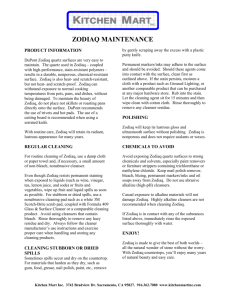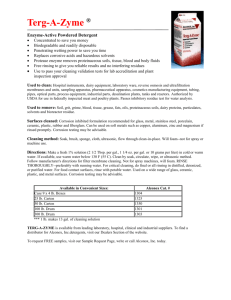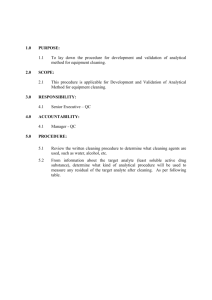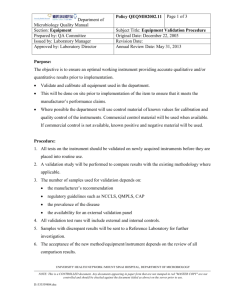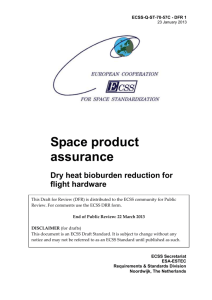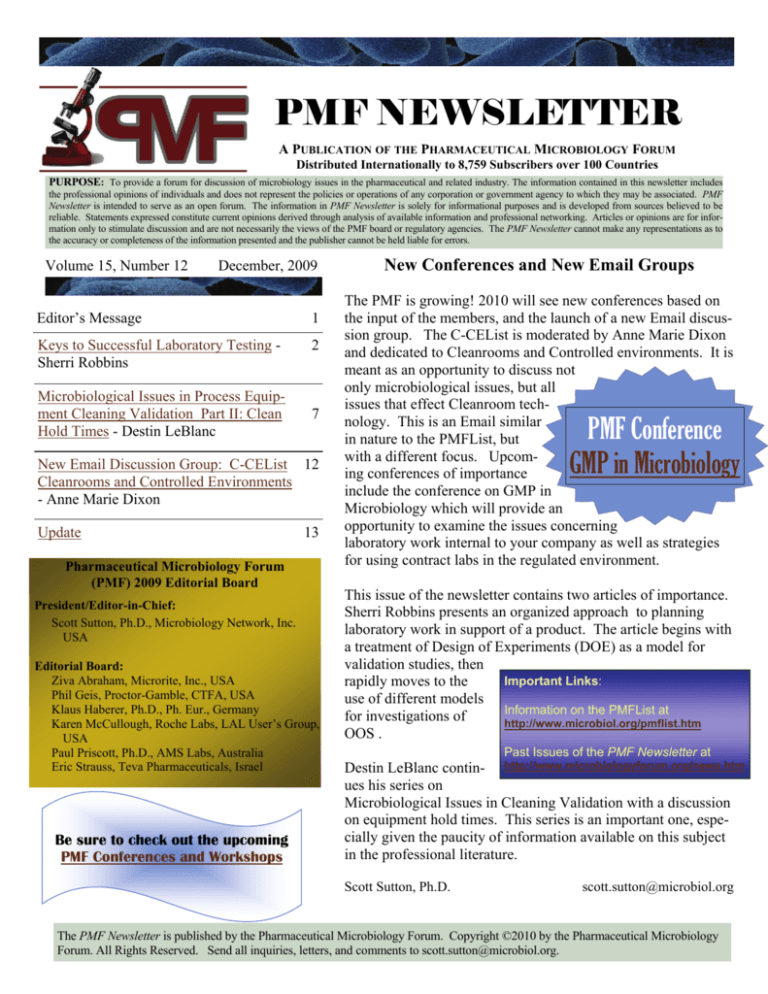
PMF NEWSLETTER
A PUBLICATION OF THE PHARMACEUTICAL MICROBIOLOGY FORUM
Distributed Internationally to 8,759 Subscribers over 100 Countries
PURPOSE: To provide a forum for discussion of microbiology issues in the pharmaceutical and related industry. The information contained in this newsletter includes
the professional opinions of individuals and does not represent the policies or operations of any corporation or government agency to which they may be associated. PMF
Newsletter is intended to serve as an open forum. The information in PMF Newsletter is solely for informational purposes and is developed from sources believed to be
reliable. Statements expressed constitute current opinions derived through analysis of available information and professional networking. Articles or opinions are for information only to stimulate discussion and are not necessarily the views of the PMF board or regulatory agencies. The PMF Newsletter cannot make any representations as to
the accuracy or completeness of the information presented and the publisher cannot be held liable for errors.
Volume 15, Number 12
December, 2009
Editor’s Message
1
Keys to Successful Laboratory Testing Sherri Robbins
2
Microbiological Issues in Process Equipment Cleaning Validation Part II: Clean
Hold Times - Destin LeBlanc
7
New Email Discussion Group: C-CEList 12
Cleanrooms and Controlled Environments
- Anne Marie Dixon
Update
13
Pharmaceutical Microbiology Forum
(PMF) 2009 Editorial Board
President/Editor-in-Chief:
Scott Sutton, Ph.D., Microbiology Network, Inc.
USA
Editorial Board:
Ziva Abraham, Microrite, Inc., USA
Phil Geis, Proctor-Gamble, CTFA, USA
Klaus Haberer, Ph.D., Ph. Eur., Germany
Karen McCullough, Roche Labs, LAL User’s Group,
USA
Paul Priscott, Ph.D., AMS Labs, Australia
Eric Strauss, Teva Pharmaceuticals, Israel
Be sure to check out the upcoming
PMF Conferences and Workshops
New Conferences and New Email Groups
The PMF is growing! 2010 will see new conferences based on
the input of the members, and the launch of a new Email discussion group. The C-CEList is moderated by Anne Marie Dixon
and dedicated to Cleanrooms and Controlled environments. It is
meant as an opportunity to discuss not
only microbiological issues, but all
issues that effect Cleanroom technology. This is an Email similar
in nature to the PMFList, but
with a different focus. Upcoming conferences of importance
include the conference on GMP in
Microbiology which will provide an
opportunity to examine the issues concerning
laboratory work internal to your company as well as strategies
for using contract labs in the regulated environment.
PMF Conference
GMP in Microbiology
This issue of the newsletter contains two articles of importance.
Sherri Robbins presents an organized approach to planning
laboratory work in support of a product. The article begins with
a treatment of Design of Experiments (DOE) as a model for
validation studies, then
Important Links:
rapidly moves to the
use of different models
Information on the PMFList at
for investigations of
http://www.microbiol.org/pmflist.htm
OOS .
Past Issues of the PMF Newsletter at
Destin LeBlanc contin- http://www.microbiologyforum.org/news.htm
ues his series on
Microbiological Issues in Cleaning Validation with a discussion
on equipment hold times. This series is an important one, especially given the paucity of information available on this subject
in the professional literature.
Scott Sutton, Ph.D.
scott.sutton@microbiol.org
The PMF Newsletter is published by the Pharmaceutical Microbiology Forum. Copyright ©2010 by the Pharmaceutical Microbiology
Forum. All Rights Reserved. Send all inquiries, letters, and comments to scott.sutton@microbiol.org.
Pharmaceutical Microbiology Forum Newsletter – Vol. 15 (12)
Keys to Successful Laboratory Testing
Sherri Robbins
Director, Regulatory Affairs
Nelson Laboratories, Inc.
Successful processes are a result of successful planning.
Whether you are designing your own process or following
a compendial method, you can establish a process that will
decrease your error rate, reduce your cost of poor quality,
and increase your
bottom line. After
Keys to Successful Lab Testing
all, increasing you
Design of Experiment
bottom line is
Process
Failure Mode and Effects
never a bad idea!
Analysis
Critical Control Points
Statistical Process Control
Process Mapping
Process Validation
By strategically
investing in the
cost of quality
through the use
of
Design of Experiment (DOE) within validations, Process Failure Mode
and Effects Analysis (PFMEA), recognition of Critical
Control Points (CCP), Statistical Process Control, (SPC),
process mapping, and careful planning, you can build a
testing process that will deliver reliable results with a low
occurrence of laboratory error. Let’s discuss how each of
these concepts can be applied to any testing scheme.
Validation using Design of Experiments (DOE):
Validation of any testing process is required in our GMP
environment; however you should optimize your validation
effort in order to get the most out of it. The validation, in
itself, can become a critical tool for identifying the performance characteristics of your analytical method and ensuring that processes are operating under optimum conditions. One approach to optimizing your efforts and reducing cost is utilizing the DOE approach. This approach varies from the traditional “one factor at a time” testing approach we often use in designing a validation. With DOE,
multiple factor variations can be combined into fewer trials
while still meeting statistically valid sampling requirements. 1 This approach also allows for a more efficient use
of personnel, time, materials, etc.
Although the concept of DOEs is simple, to master the ap-
proach may take specialized training. The following list
represents the simplified steps to consider when implementing a DOE strategy for your validation.
Step 1: Decide the project objectives. To start, you
should facilitate a brainstorming session with the necessary key individuals (i.e. subject matter expert, chief
scientist, etc.).2 The factors that should be included are:
• The levels and interactions of the factors to be challenged
• How many samples to challenge
• How to measure objectives
• The criteria for evaluating the data
(Continued on page 3)
Pharmaceutical Microbiology Forum Newsletter – Vol. 15 (12)
Page 3 of 13
(Continued from page 2)
Your design may be limited by the cost or availability
of the samples themselves, so you may want to optimize the test design to the challenge the most critical
known variables.
Step 2: Establish your factor design matrix. This is
also known as an orthogonal array. For example, if
you are interested in three different factors (i.e. incubation time, temperature, media component), at two levels (high and low), with three samples at each condition, your array would look like the following:
Experiment
A
Factors
B
C
Samples
1
1
1
1
X1, Y1, Z1
2
1
2
2
X2, Y2, Z2
3
2
1
2
X3, Y3, Z3
4
2
2
1
X4, Y4, Z4
Taguchi recommends minimizing the variability in the
product's performance in response to noise factors,
while maximizing the variability in the response to signal factors. Noise factors are those that are not under
the control of the operator and are considered to be the
baseline variability in the method; such as weather,
vibrations, etc. Signal factors are those which are under the direct control of the operator; such as time,
temperature, pressure, etc. The goal is to find the best
settings of factors under your control in order to maximize the signal to noise (S/N) ratio. This will enable
you to determine what the true signal results really are.
Step 3: Execution of your array. In order to reduce
error or bias between and within experiments, you
should conduct your experiments in random order. 2
This can be achieved by randomly selecting your sample and submitting it to the predetermined test matrix
and procedure.
Step 4: Interpretation of the data. In order to visualize the interactions between variables, you should
plot your findings graphically. If interactions are simple, you can chart the results using a linear regression.
However, if your variables do not result in a direct correlation with each other, you could visualize the interactions using a 3-D charting technique.
Step 5: Confirmation. It is wise to confirm your most
critical findings since your results were based on a sampling of the population and there will always be some
level of uncertainty in the measurements you have obtained. You should also establish an acceptable confidence level before moving forward.
Since the use of DOE will demonstrate the effects of
altering process parameters on desired outcomes, you
can use this information to establish the “design space”
of your process. Knowing your validated design space
(Continued on page 4)
Pharmaceutical Microbiology Forum Newsletter – Vol. 15 (12)
Page 4 of 13
(Continued from page 3)
allows you to assess impact of process changes going
forward. Depending on the change, this may minimize your validation effort since you have already
established the effects of your limits in the original
validation. With knowing the robustness of parameter effects, you can also optimize your process resulting in improved process capability (CpK).
Process Failure Mode and Effects Analysis
(PFMEA) and Critical Control Points (CCPs):
Process failure mode and effects analysis is an important tool to identify where the greatest failure risks
are in your process. When these are identified, you
are then able to take mitigation steps significantly
reduce the opportunity for occurrence. This is when
process mapping can become an effective tool in
helping to identify all the sub processes of your analytical method. This will assist you in a more comprehensive approach to identifying the failure modes
of the process.
To successfully utilize a PFMEA assessment, you
should follow these general steps using a brainstorming format:
1. Identify each process step by creating a process map to assist in visualizing the flow and
any failure contributions.
2. Identify all of the ways the process can fail.
Info can be taken from DOE data or already
existing known failures, such as deviations,
out of specification, etc.
3. List the potential effects of each identified
failure, then rank the severity of the effect.
4. Evaluate and document the potential causes
of the identified failure modes.
5. Rank the possibility of the occurrence of the
causes, taking into consideration any existing
controls if you are assessing an already existing process.
6. Rank the ability to detect the failure mode.
7. Calculate the risk levels of each failure mode.
This is normally based on the product of the
severity, occurrence, and detectability scores.
8. Prioritize your mitigation efforts based on the
risk levels that are determined to be not acceptable for your process.
9. Develop your action plan for each mitigation
step.
10. Implement your actions.
11. After implementation, recalculate the new risk
score to determine if further actions are necessary or if you have reached an acceptable risk
level.
12. Keep the process dynamic by updating the failure mode document with each new failure discovered or with any changes in the process,
subsequent to the initial assessment.
Note: Failures are not always a one to one ratio of cause
and effect. You may benefit from conducting a Fault
Tree Analysis (FTA) to determine where successive
minor failure modes may lead to a critical failure.
Critical Control Points (CCPs) are usually paired with
Hazard Analysis and Critical Control Points (HACCP).
However, since we are not designing a product in this
(Continued on page 5)
Pharmaceutical Microbiology Forum Newsletter – Vol. 15 (12)
Page 5 of 13
(Continued from page 4)
application, the hazard analysis portion will not be
discussed in this article. The concept of CCPs, and
the ease of applying it to a testing process is what
we are focused on. Because you now know where
your failure modes may occur and your failure parameters from your DOE testing, you already know
where the critical points are in your process. All
failure modes may not be a critical control point.
CCPs are a way to define the “make or break” failure modes.
With each CCP identified, you should ensure a control or barrier is in place to mitigate any potential
failure. These controls or barriers can either be secondary verification points, procedural controls, or
physical controls to Poka-Yoke your process. An
example would be placing a cover on a temperature
controller to avoid accidental adjustments to the
process.
Statistical Process Control (SPC):
SPC can be a valuable tool in predicting out of
specification conditions. By charting critical process measurements, you can distinguish common
cause variation (a.k.a noise) from special cause
variation. It is the special cause variations that
should be concerning to us when controlling our
process. Charting can show you where a shift or
change in a process has occurred. You can then
proactively repair your process, prior to reaching
out of control conditions. For example, if you were
to routinely use a sterilizer, you could chart a leak
test results to predict seal failures.
There are two types of measurement which you can
plot on a Control Chart:
Variables: “how much” – measured in quantitative units
Attributes: “how many”- measured in counts
This decision tree can help you identify the type
of Control Chart you need.3 (see next page) .
The tools previously described are some of the
quality tools you need in your toolbox. To get desirable results, you need to use the most appropriate
tool(s) to achieve what is necessary for your purpose. Remember that you are in control of the cost
of quality investment that is needed when designing
a process; however you may not be able to control
the cost of poor quality.
References:
1. Dr. D. Dixon, Dr. J Eatock, Prof. B.J. Meenan,
and M. Morgan. 2006. Application of Design of
Experiments (DOE) Techniques to Process Validation in Medical Device Manufacture, Journal
of Validation Technology, Feb 2006, Volume
12, Number 2.
2. Roy, Ranjit K., 2001, Design of Experiments
using the Taguchi Approach: 16 Steps to Product
and Process Improvement.
3. http://syque.com/quality_tools/tools/
Tools69.htm
Pharmaceutical Microbiology Forum Newsletter – Vol. 15 (12)
Page 6 of 13
What Control Chart
shall I use?
A subgroup contains all
of the measurements that
make up one plotted point
An item is a thing that may
be rejected if any number
of defects are found in it
What type of data
is being measured?
Measured in units
Counted
Variable
Attribute
What is being counted?
How many measurements
are to be in each subgroup?
One
Two to ten
Over ten
Individuals
and Moving
Range
Average
and Range
Average &
Standard
deviation
(X, MR)
(X-bar, R)
(X-bar, s)
No
Yes
Defective items
(which may contain
several defects)
Defectives
Will there be a constant
number of measurements
in each subgroup?
No
Choose either chart
Total defects
in all items
Defects
Will there be a constant
number of measurements
in each subgroup?
Yes
Choose either chart
Proportion
defective
Number
defective
Defects per
subgroup
Defects
per unit
(p chart)
(np chart)
(c chart)
(u chart)
Pharmaceutical Microbiology Forum Newsletter – Vol. 15 (12)
Page 7 of 13
Microbiological Issues in Process Equipment Cleaning Validation
Part II: Clean Hold Studies
Destin LeBlanc
Cleaning Validation Technologies
This is the second part of a discussion of microbial
issues for the cleaning of process equipment
“product-contact” surfaces. (1) This emphasis for
this second part is a discussion of microbial issues
in clean hold time studies. “Clean hold” deals with
the time between the end of the cleaning process
and the start of the next “use” of that cleaned equipment. That next use may be manufacture of a product, but may include a SIP (steam in place) process
to sterilize or sanitize the equipment. Concerns
about storage conditions are related to possible recontamination of the equipment, including recontamination by micro-organisms. Therefore, the
clean hold time is concerned about the hold time
under defined storage conditions.
Regulatory background
The regulatory basis of addressing the clean hold
time is apparent from the FDA cleaning validation
guidance:
“There should be some evidence that routine cleaning and storage of equipment does
not allow microbial proliferation. For example, equipment should be dried before
storage, and under no circumstances should
stagnant water be allowed to remain in
equipment subsequent to cleaning operations.” (2)
This concern is also reflected in the PIC/S recommendations for cleaning validation:
“The period and when appropriate, conditions of storage of equipment … and the
time between cleaning and equipment reuse, should form part of the validation of
cleaning procedures. This is to provide confidence that routine cleaning and storage of
equipment does not allow microbial proliferation. In general, equipment should be stored
dry, and under no circumstances should stagnant water be allowed to remain in equipment
subsequent to cleaning operations.” (3)
In both these documents, the major concern is bioburden proliferation during storage (during the clean
(Continued on page 8)
Pharmaceutical Microbiology Forum Newsletter – Vol. 15 (12)
Page 8 of 13
hold time). It should be noted that there may be other
concerns from manufacturers, such as recontamination
from other sources (particles, for example) that may
also be addressed in a clean hold study. However, the
major concern is generally bioburden proliferation.
such that the data collected at the end of the cleaning
process also serves as the data for the beginning of the
clean hold protocol. In other cases, the two protocols
can be separate in time, such the baseline data for the
clean hold study is developed apart from the data at
the end of the cleaning process validation protocol.
Bioburden proliferation
Setting limits
For bioburden proliferation in a clean hold study,
bioburden is measured at the beginning of the storage
time (which is also the end of the cleaning process)
and at the end of the storage time (which is also the
beginning of the next use). A clean hold study generally follows validation of the cleaning process itself,
because the initial storage state or condition depends
on the cleaning process used. The variables that affect
possible changes in bioburden include the initial storage state (including initial bioburden, the initial organic nutrient load, and the presence of water, particularly pooled water), the time of storage, the temperature of storage, and protection from external recontamination.
The key question for a clean hold study is how to set
appropriate limits for microbial or bioburden proliferation. The main issue is to prevent significant
‘”proliferation”, and not just any change. One element
in determining “significant” proliferation” is the issue
of bioburden enumeration (discussed in Part I). Doubling or even tripling of enumerated bioburden is not
considered significant. Generally, a one log increase
in bioburden would be considered significant. That is,
even though the bioburden acceptance limit at the end
(Continued from page 7)
Protocol strategies
Some companies may include the validation of the
clean hold time as part of an overall protocol, including the cleaning process validation. That is, one protocol is executed which measure residues at the end of
the cleaning process. Among those residues is bioburden. That bioburden at the end of the cleaning process
provides an assurance that the cleaning process produces acceptable level of bioburden. See Part I
(October 2009 PMF Newsletter) for a discussion of
setting bioburden limits at the end of the cleaning
process. Those values at the end of the cleaning process are also the baseline (time = 0) for measuring
bioburden proliferation during the clean hold time.
Following a maximum allowed storage time (under
specified storage conditions, such as location), bioburden is measured again to determine whether bioburden
proliferation occurred.
Some companies will separate the clean hold validation protocol from the cleaning process validation protocol. This can be either a separation by using two protocols, but still having the clean hold protocol immediately follow the cleaning process validation protocol
(Continued on page 9)
Pharmaceutical Microbiology Forum Newsletter – Vol. 15 (12)
Page 9 of 13
(Continued from page 8)
of the cleaning process was 1 CFU/cm2, that value
could be has high as 10 CFU/cm2 and still be acceptable after the hold time. While it might seem there is
an inconsistency here, remember in Part I that the
limit of (for example) 1 CFU/cm2 was not based on a
carryover calculation. It was based on what was
should be achievable by cleaning with hot, aqueous
alkaline cleaning solutions. Therefore, it is considerably below what would be acceptable for contamination of the next product. Therefore, an acceptance
criterion of no more than (NMT) a one log increase
in bioburden is reasonable to consider for a clean
hold study.
However, a criterion of no more than a one log increase is difficult to apply when the swab results
come back all zeros. (Let’s ignore for now how that
data should actually be reported.) There is no such
value as a “log of zero”. For that reason, it is reasonable to allow no more than the original acceptance
limit in the cleaning validation protocol. If that is the
case, then an additional criterion can be “NMT 1
CFU/cm2” (for example).
These two criteria can be combined by establishing
an acceptance criterion of “the less stringent of NMT
1 CFU/cm2 and NMT one log increase”. For example, if the acceptance limit at the end of cleaning was
25 CFU per 25 cm2, and if the measured bioburden
value at the end of cleaning is 5 CFU per swab of 25
cm2, then after the clean hold time, the acceptance
criterion would be the less stringent of 50 CFU per
25 cm2 (a one log increase) and 25 CFU per 25 cm2
(the original specification after cleaning). The less
stringent of the two is the higher value, or 50 CFU
per 25 cm2. On the other hand, if the acceptance limit
at the end of cleaning was 25 CFU per 25 cm2, and if
the measured bioburden value at the end of cleaning
is 1 CFU per swab of 25 cm2, then after the clean
hold time, the acceptance criterion would be the less
stringent of 10 CFU per 25 cm2 (a one log increase)
and 25 CFU per 25 cm2 (the original specification
after cleaning). The less stringent of these two is the
higher value, or 25 CFU per 25 cm2.
Sampling issues
If multiple swab sites (or contact plate sites) are sampled for a given equipment item, it probably is not
appropriate to average sites and then compare the average value after the clean hold time to the average
value before the clean hold time. In such cases, sampling after the clean hold time should be with sites
adjacent to the sites sampled for the beginning of the
clean hold times. Comparisons then should be made
for “comparable” sites, that is, for those adjacent sites.
Problems also arise in clean hold studies when rinse
sampling is done for bioburden measurement. One of
two types of rinse sampling may be performed. If the
initial (time = zero) bioburden rinse sample is a
“grab” sample of the final process, then the rinse
sample after the clean hold time should be an ambient
temperature rinse. If a hot water rinse were to be
used, then any proliferation of bioburden during the
clean hold time may be masked by the killing effect
(Continued on page 10)
Pharmaceutical Microbiology Forum Newsletter – Vol. 15 (12)
Page 10 of 13
(Continued from page 9)
of the hot rinse. If a sufficient quantity of ambient
temperature water is not readily available, this approach may be problematic.
The other type of rinse used is a separate sampling
rinse. That is, for the initial bioburden determination
the process rinse is completed and is then followed
by a rinse solely for sampling purposes. If this separate sampling rinse is used, then the same issue with
hot water rinsing arises – if the separate rinse sample is with hot water, the data relating to proliferation may be distorted due to the biocidal effect of
the temperature. Another consideration is that if a
separate sampling rinse is used at the end of the
cleaning process, then it is no longer possible to use
the data from a sampling rinse after storage of the
cleaned equipment for that manufacturing run. The
reason for this is that using such a separate sampling
rinse is an additional step which distorts the nature
of the cleaned equipment during storage. The purpose of the clean hold study is to measure bioburden
change following the normal cleaning process, not
following the use of a separate sampling rinse
(which is only used for the validation protocol). In
this case, one production run must be used to develop the initial (time = zero) data, and then a separate manufacturing run must be used to develop the
data for the burden at the end of the storage period.
While not an ideal situation, it is a required constraint if a separate sampling rinse is used for measuring bioburden.
When establishing a clean hold time by use of a protocol, it is best to establish a goal and measure for
the presence of proliferation only at the end of that
time period. Sampling at various intervals to determine the maximum acceptable time can present
problems in terms inadvertent contamination of surfaces during swab or contact plate sampling at the
intermediate times, thus resulting in false failures at
later time periods. In addition, rinse sampling at intermediate times cannot be performed for one manufacturing run only. For rinse sampling at multiple
times, a separate run must be used for each time period. If such studies involving testing at multiple
time points are performed, they are best done as part
of the design/development phase of validation.
Objectionable organisms
Identification of organisms and exclusion of objectionable organisms may also be utilized in a clean
hold study. The principles used for the cleaning validation protocol (See Part I, PMF Newsletter, vol.,
no., pages, date) will also apply here. However, if
there is no significant proliferation, there may be
little rationale for identification beyond what was
done at the end of cleaning. On the other hand, if
there is significant proliferation (i.e., a failure of the
clean hold protocol), then identification is certainly
(Continued on page 11)
Pharmaceutical Microbiology Forum Newsletter – Vol. 15 (12)
Page 11 of 13
(Continued from page 10)
appropriate as part of the investigation to determine the
cause of the failure.
Endotoxins
If endotoxin is measured for a cleaning validation protocol for sterile manufacturing, it is not necessary to
include endotoxin measurement as part of the clean
hold protocol. The rationale for this is that excessive
endotoxin is only likely to be a problem if there is also
significant microbial proliferation. That is, the protocol
is likely to fail for endotoxin only if there is also a failure for bioburden. In addition, failure for endotoxin will
only occur if the bioburden proliferation involves gram
negative bacteria. While it is theoretically possible for a
gram negative to proliferate and then die (thus resulting
in no bioburden proliferation detected at the end of the
storage time, but with excessive endotoxin), such a scenario is not likely.
Alternative to a formal protocol
An approach utilized by some companies is to avoid
formal clean hold studies by providing assurance that
the equipment is dry at the beginning of the hold time.
This is consistent with the FDA’s statement in their
cleaning validation guidance:
“This consists largely of preventive measures rather
than removal of contamination once it has occurred.
There should be some evidence that routine cleaning and storage of equipment does not allow microbial proliferation. For example, equipment should
be dried before storage, and under no circumstances
should stagnant water be allowed to remain in
equipment subsequent to cleaning operations.” (4)
In other words, the major issue is one of preventive actions to make sure that the equipment is dry. It is a well
accepted scientific principle that bioburden will not proliferate on clean, dry surfaces. Assurance of dryness can
be done by proper design of fixed equipment to assist in
adequate drainage, proper placement of items cleaned
out of place to assist in adequate drainage, use of a hot
water final rinse, use of hot air following the final rinse,
and/or use of an alcohol wipe or rinse following the final water rinse. In addition, it should be established that
dry surfaces do not become wet following initiation of
the clean hold time. For example, if vessels cleaned by
a CIP process are closed up before returning to ambient
temperature, moist heated air may condense water in
parts of the equipment, possibly allowing microbial proliferation.
References
1. See PMF Newsletter 15:10, pp. 2-9 (October 2009)
for Part I.
2. Guide to Inspections of Validation of Cleaning Practices, U.S. Food and Drug Administration, Washington, D.C., U.S. Government Printing Office, July
1993.
3. Recommendations on Validation Master Plan, Installation and Operational Qualification, Non-Sterile
Process Validation Cleaning Validation, Pharmaceutical Inspection Convention Pharmaceutical Inspection Co-Operation Scheme (PIC/S), Document PI
006-3, Geneva, Switzerland, September 15, 2007.
4. Guide to Inspections of Validation of Cleaning Practices, U.S. Food and Drug Administration, Washington, D.C., U.S. Government Printing Office, July
1993.
Pharmaceutical Microbiology Forum Newsletter – Vol. 15 (12)
Page 12 of 13
New Email Discussion Group - C-CEList
Cleanrooms & Controlled Environments
Anne Marie Dixon
Cleanroom Management Associates, Inc.
Cleanrooms and Controlled Environments offer significant challenges today. Regulations, standards, “c”
in GMP, technical articles, and research all add to the
volume of information that users need to design, build,
operate and maintain these facilities.
If you research the number of technical publications
that could contain information on these subjects, the
monthly total will exceed over 300. If you include all
of the technical conferences, standards meetings, etc. –
both national and international – the numbers are over
100 per year. Enormous amounts of technical information are written and presented every day. The WEB
does not include all of the current information, as technical conferences papers are generally not available.
Standards meetings and advance document copies are
also not generally available through the WEB.
So, where do you go in today’s complex world to get
some insight or references or assistance? The C-CE
list was established to help the cleanroom and controlled environment user for this purpose by creating a
format for these subjects. Many members of the CE
family are members of technical standards committees
and are aware of the information or changes that are
forthcoming.
The mailing list works as follows: email messages sent
to the C-CEList are distributed by the list server to all
subscribers. Replies are sent then sent back to all subscribers (participants must be subscribers to the free
service). All messages go through a moderator for
approval.
Participation in the list is free due to the generosity of
our sponsors. The usefulness of the mailing list depends on the amount (and quality) of information disseminated through the list. This will be a very active
list, and we encourage you to support this venture. We
have a complete archives of the list.
Questions posed are never too basic or too complex!
The only criteria is that the question is on the subject
of cleanrooms and controlled environments ----it
could contain any of the following subject matter--Personnel
Facility
Cleaning and Sanitization
Maintenance
Environmental Monitoring
Validation
Standards
And More…
All of these questions or comments are welcome in
this format. We encourage you to join and participate ----
Register for the List
Pharmaceutical Microbiology Forum Newsletter – Vol. 15 (12)
Page 13 of 13
Upcoming Events
PMF Workshop on GMP for the Microbiology Lab
May 17-18, 2010
Baltimore, MD
PMF Workshop on Risk Considerations in the Investigation of Microbiological Data Deviations
June 7-8, 2010
Chicago, IL
PMF Conference on Advanced Topics in Cosmetic
Microbiology
September 13-14, 2010
Philadelphia, PA
2010 PMF Fall Forum
October 7-8, 2010
Rochester, NY. for the lab or the manufacturing
The Microbiology Network (http://www.microbiol.org) was
established in 1996 and provides consulting and training services to industry. It also supports the PMFList, a microbiology Email list (http://www.microbiol.org/pmflist.htm) and
the PSDG Email list (pharmaceutical stability topics)
(http://www.microbiol.org/psdglist.htm).
IN-HOUSE COURSES (save training budget)
- cGMP (Lab Audit)
- Contamination Control
- Environmental/process Monitoring
- Objectionable Organisms
- Process Control of Bioburden
- Investigation of OOS (MDD)
WEBINARS
See listing at http://micronetwork.webex.com
CONSULTING SERVICES
- Aseptic Process (EM, Facility Qualification and Sanitization)
- Contamination Control Evaluatio
- Investigations of OOS (MDD)
- Lab Operations and Audits
- Investigations
- Project Management
- Expert Witness
Sartorius is an internationally leading laboratory and process
technology supplier covering the segments of biotechnology
and mechatronics. Sartorius has over 75 years experience in
the manufacturing of cellulose nitrate membranes which are
routinely used today for microbiological analysis.
The detection of microbial contamination in sample liquids
such as final product, incoming inspection or during inprocess testing plays a significant role in the quality assurance process. The requirements for a practical microbiological test method are that it permits quantitative and reproducible detection of trace contamination and that it can be performed efficiently and economically under routine conditions.
These requirements are fulfilled optimally by the membrane
filtration method. The membrane filter method is worldwide
accepted and the preferred method for analyzing aqueous
solutions for microbial contamination.
Sartorius offers an extensive line of high quality and reliable
membrane-based solutions for all your microbial analysis
needs, specifically for microbial enumeration, sterility
testing and air monitoring. To learn more about Sartorius
Microbiology Products, please visit us at:
www.Sartorius.com/microbio.
Discussion List Update
PMFList:
Number of Subscribers: 3813
Number of Countries: 88
Number of Messages Last Month: 183
PSDGList (Pharma Stability Discussion Group):
Number of Subscribers: 1237
Number of Countries: 34
Membership is FREE. To join the PMFList, visit
http://microbiol.org/pmflist.htm and register.
A sister Email is devoted to topics in the stability testing
of pharmaceuticals, medical devices and personal products.
To join the PSDGList, visit
http://microbiol.org/psdglist.htm and register.
You can ask, answer, or read questions and comments
from your colleagues. Archives of the lists are available at:
• http://lists.microbiol.org/archives/PMFLIST.html
• http://lists.microbiol.org/archives/PSDGLIST.html


